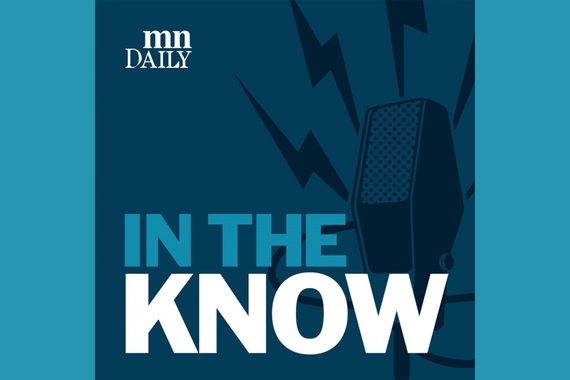“The Material Needs to Tell the Story”
In February 2024, fueled by the resources of the newly established Minnesota Human Rights Archive, the University of Minnesota Libraries, the Human Rights Program, and the Wilkins Center for Human Relations and Social Justice unveiled the Global Reach of Local Activism exhibit. The exhibit is a new collection that traces the worldwide impact of Minnesotan human rights contributions. It highlights Minnesotan activists’ work to end gender-based violence, racial discrimination, and the use of torture. It is the first in an ongoing series that spotlights unique and extensive archival resources. Read the exhibit details here.
Darren Terpstra is an exhibit designer for the University of Minnesota Libraries with over twenty years of experience. He created the set materials for the Global Reach of Local Activism exhibit. Terpstra spoke to the Human Rights Program about the creative design process and his experience bringing the Global Reach of Local Activism exhibit to life. His responses have been edited for clarity and length.
Tell us about yourself and some of your professional background and experiences.
My background is kind of odd in a way. I started out with a degree in Visual Communications. That offered a lot of opportunity to move into areas of design or areas of marketing, media, and public relations. It left a lot of doors open. Most of my background before the University of Minnesota has been in theme parks and entertainment. With that background, you start to understand things like themed environments and engaging the public, lighting, real estate space, room and area. To design, you have to think of everything—flooring, walls, lighting. Winding up at the University of Minnesota in the Archives and Special Collections was a nice surprise and allowed me to marry those skills with the needs of presenting information and exhibits to the public.
What initially sparked your interest in archives and especially the art and design of exhibitions?
It wasn’t where I started. I started in the UMN Libraries in the Communications Office almost twenty years ago. I thought I was just going to be there for a brief period of time until I found the next move in my career. Little did I know my career would end up being at the UMN! As I was in communication with the Libraries, I started seeing their exhibit program. I realized with my background, if I could take on that program and start working directly with the curators, I could elevate the level of exhibits we do, the amount of exhibits, and the impact on our audience. When I presented that vision to my supervisor at the time, she and the Libraries’ dean agreed we should give that a try.
Can you take us behind the scenes of exhibit-making and explain the process?
The initial step is meeting with the curator. I’m not pulling materials, developing the theme, or writing the text—that’s the curator. But for me to create visual materials, posters, advertising, banners, signage, some sort of immersive environment for the exhibit, I need to know what is in the mind of the curator. Not only the subject but what about human rights the curator wants to share. There are so many different facets of human rights—global, local, etc. The curators of the Global Reach of Local Activism exhibit focused on human rights in Minnesota. Those are all things I need to know in order to make sure the look of the exhibit matches what they want to say.
By and large, I will take the curators’ information and come back with something that is hopefully greater and bigger than they've imagined. Oftentimes our curators really like the ideas and creative expertise I offer them. It's a good collaboration between research and design, as they spend their time in the books and caverns, looking at print and type while I am out in the marketplace, at the Mall of America, in retail stores, interacting with students and looking at the Internet and popular media—anything that allows me to stay current on what is in the minds of people in pop culture. I understand what will be relevant and resonate with our audience, and the curators feed me the information, research, and images they want to show in the exhibit. The more clarity I have, the better I feel about presenting their subject matter.
Additionally, I have to understand the timeframe. How long do we have to work on this? Who is the audience going to be? Who do the curators want to reach? I feel there are always two audiences. One is the audience that is going to be automatically interested in what the curators are presenting. The second is the people who don’t realize that they would be as interested in the subject matter as they perhaps are. With good marketing and good promotion, we hopefully can pique people’s interest, attract a broader audience, and get people to come see and listen to the material we are presenting.
What was your design/creative process like for the Global Reach of Local Activism exhibit? What factors did you consider when putting the design work together? What kind of message did you wish to convey?
With this exhibit, I had to take such a dense amount of information and distill it down to a simple but effective visual. That can be hard. So I attended some meetings with the curators and other people involved. I read through all of the information and research they presented to me, looked through all of the images, and spent time talking to all of the people involved. Given the complexity, the scope, and the nuances of this exhibit, I felt like it was going to be better to keep the theming and graphic design simple. So for example, take the title, “Global Reach of Local Activism.” We’re talking global, and then we’re talking local. I thought that the silhouette of the shape of Minnesota, the line art of a globe that most people associate with the world, and a simple-textured, somewhat plain background was the best fit because it says everything you need to say in a quick visual. The topic was more sobering. It couldn't have fun fonts or bright backgrounds, but it still needed to stay hopeful—it couldn’t be dark or brooding either. I had to find the middle ground of a somewhat ubiquitous canvas, because ultimately the writing, the text, and the images need to speak. The material needs to tell the story. The design just helps push it along and creates an environment for that story to live in.
What was the most challenging part of designing the Global Reach of Local Activism exhibit?
It’s difficult being a designer when there are many stakeholders and different opinions involved in a project. Until I get everyone on the same page, I can’t go anywhere and advance the project. In this case, there were student workers, graduate students, professors, retirees, and a lot of other curators in the archives, so I had to think about getting the project narrowed down to the most succinct, easy-to-present exhibit that allows people to easily understand the information.
What was your favorite part about designing the Global Reach of Local Activism exhibit?
I think my favorite part with this exhibit—and many exhibits I work on—is arriving at the point when the art direction for the signage, the posters, and look and feel of the exhibit is complete, when it feels cohesive, appropriate, and feels like I’ve hit the target. Because then everything else falls into place!
The people of Minnesota have a time-honored tradition of human rights advocacy. Under Darren’s artistry and direction, the exhibit pays homage to Minnesota’s complex human rights story while recognizing the unfulfilled promise and unfinished work of local activism. It both preserves the past and allows viewers to imagine a new future that respects the dignity of all human individuals.
Visit the Exhibition!
The Global Reach of Local Activism: Minnesota’s Human Rights Stories exhibit is free and available to the public on the second floor gallery in Elmer L. Andersen Library until June 7, 2024. The exhibit is open during library hours (9 A.M. to 5 P.M. on Monday, Tuesday, Friday; 9 A.M. to 6 P.M. on Wednesday and Thursday).



